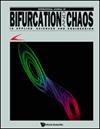Characterization of the Riccati and Abel Polynomial Differential Systems Having Invariant Algebraic Curves
IF 2.3
4区 数学
Q2 MATHEMATICS, INTERDISCIPLINARY APPLICATIONS
引用次数: 0
Abstract
The Riccati polynomial differential systems are differential systems of the form , , where and for are polynomial functions. We characterize all the Riccati polynomial differential systems having an invariant algebraic curve. We show that the coefficients of the first four highest degree terms of the polynomial in the variable defining the invariant algebraic curve determine completely the Riccati differential system. A similar result is obtained for any Abel polynomial differential system.
具有不变代数曲线的里卡蒂和阿贝尔多项式微分系统的特征
Riccati 多项式微分方程系是形式为 x′=c0(x),y′=b0(x)+b1(x)y+b2(x)y2 的微分方程系,其中 i=0,1,2 的 c0 和 bi 是多项式函数。我们描述了所有具有不变代数曲线的 Riccati 多项式微分方程系统。我们证明,定义不变代数曲线的变量 y 的多项式的前四个最高阶项的系数完全决定了 Riccati 微分系统。对于任何阿贝尔多项式微分方程系,都可以得到类似的结果。
本文章由计算机程序翻译,如有差异,请以英文原文为准。
求助全文
约1分钟内获得全文
求助全文
来源期刊
CiteScore
4.10
自引率
13.60%
发文量
237
审稿时长
2-4 weeks
期刊介绍:
The International Journal of Bifurcation and Chaos is widely regarded as a leading journal in the exciting fields of chaos theory and nonlinear science. Represented by an international editorial board comprising top researchers from a wide variety of disciplines, it is setting high standards in scientific and production quality. The journal has been reputedly acclaimed by the scientific community around the world, and has featured many important papers by leading researchers from various areas of applied sciences and engineering.
The discipline of chaos theory has created a universal paradigm, a scientific parlance, and a mathematical tool for grappling with complex dynamical phenomena. In every field of applied sciences (astronomy, atmospheric sciences, biology, chemistry, economics, geophysics, life and medical sciences, physics, social sciences, ecology, etc.) and engineering (aerospace, chemical, electronic, civil, computer, information, mechanical, software, telecommunication, etc.), the local and global manifestations of chaos and bifurcation have burst forth in an unprecedented universality, linking scientists heretofore unfamiliar with one another''s fields, and offering an opportunity to reshape our grasp of reality.

 求助内容:
求助内容: 应助结果提醒方式:
应助结果提醒方式:


